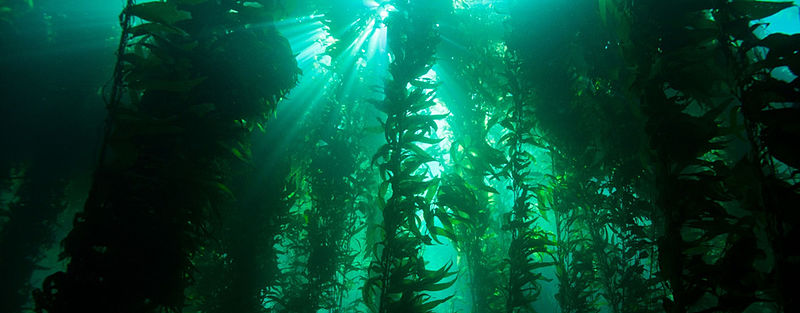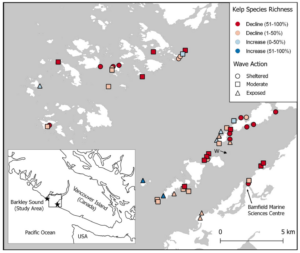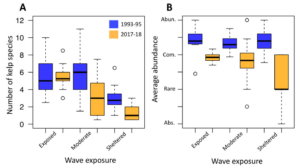On the coasts of British Columbia, habitat-forming kelp algae are on the decline. Sensitive to increasing temperatures, changing nutrient dynamics, and always at risk of being carved out of their coastal homes by storm activity, kelp seem to be on the losing side of global climate change more often than the winning. Considering the extensive list of ecosystem good and services kelp are responsible for, this global trend has many scientists worried for the future health of our coastal habitats.
There are over 30 different species of brown algae in British Columbia and kelp are probably the most conspicuous of all. The giant kelp, Macrocystis integrifolia, is often featured in documentary films about the West coast’s impressive underwater forests, but the bull-whip kelp, Nereocystis luetkeana, and Saccharina species are also common.

Each occupies a specific niche in their environment; most enjoying the stability of the lower and middle intertidal zones with some species adapted to the harsh and constantly-changing environment of the high intertidal. A number of factors determine how the many different kelp, in addition to seagrasses and other kinds of algae, will assemble themselves in these coastal communities. Survival for these sessile organisms is a constant battle for space, oxygen, light, nutrients, and available “mates” of their own species, not to mention the constant risk of being eaten by a hungry herbivore. Throw climate change into the mix, and everything gets thrown off.
While most climate models suggest a northward move for many kelp species, coastal managers know that smaller-scale factors will also play an important role in determining which kelp will adapt to their warmer neighbourhoods and which will be forced to move out. Being able to predict which species will be most affected by climate stressors on the small scale of a local bay would allow scientists to better advise fisheries, tourism groups, and other local coast-dependent industries that will undoubtedly also need to adapt their operations in the coming years.
Researchers, Starko et. al., at the University of British Columbia, Bamfield Marine Sciences Centre, University of Victoria, and University of Calgary compared kelp assemblages in exposed, moderately exposed, and sheltered coastal zones of the Barkley Sound, Vancouver Island Canada, over two time periods ~22 years apart.

They found that, on average, both the number of species (kelp richness) and amount of total kelp (kelp abundance) declined in those years, mirroring trends noted in other areas of the Pacific Northwest. While the cause of this decline is not entirely understood, climate change is thought to be a key factor.
Kelp are fast-growing algae and need relatively clear waters in order for light from the surface to reach their fronds. Climate change creates both long-term and large-scale changes, like gradually warming ocean temperatures, and shorter-scale or short-term environmental anomalies, like intense heatwaves and storms. Previous research has shown how warming waters, and the cloudy stagnant conditions they can create, can kill sensitive kelp species. There also seems to be a connection between warming oceans and the prevalence of diseases like the one that caused the infamous starfish wasting event in 2013-2014, which resulted in a surge of urchins, the starfish’s former prey, and then an eventual decline in kelp, the urchins’ prey. Intense storm activity has also been shown to dislodge large patches of kelp from their holdfasts on the ocean floor.

Starko et. al. make note of a heatwave that took place in the North Pacific between 2013 and 2016, and suggest that the event could have created stressful conditions for some sensitive kelp species in the Barkley Sound. But, other work has shown that overall kelp abundance in this area has been declining for much longer than the 2013-2016 heatwave. It seems that a number of climate-related factors are working together to re-shape these coastal communities.
Interestingly, the researchers found stark differences in how the kelp forests changed between sites over their study period. At wave-exposed sites, declines in kelp abundance were less extreme and the total number of species did not significantly change. In fact, despite the declines in number of species found in sheltered and moderately exposed sites, species richness across the entire region has not changed, due to the refuge provided by the wave-exposed sites. Only two species, Laminaria ephemera and Agarum fimbriatum, were found in the 1990s but not in the 2017-2018 surveys, and were not very common to begin with.
So, what does this mean for the future of kelp forests as we currently know them?
Under warmer conditions, whether it’s slowly-warming ocean temperatures or quickly-warming air temperatures during a heatwave, kelp become dessicated, have a harder time securing nutrients, and may experience slowed growth or even death. Starko et. al. suggest that wave-exposed sites may provide just enough water movement to both cool exposed fronds and keep nutrients moving through the forests. It’s already been suggested that large kelp forests might be more resilient to the worst effects of increasing storm activity than smaller patches, due to the buffering effect of living in a big group. We also know that some kelp are simply more tolerant of the warmer, nutrient-starved conditions seen during the 2013-2016 heatwave. Wave-exposed shorelines may provide kelp with another kind of refuge from climate change-related stressors becoming more commonplace in today’s oceans. At least, when it comes to maintaining the biodiversity of the entire kelp family…
Kelp forests are getting smaller and more disconnected as they battle a suite of climate-related hazards around the globe. If we hope to maintain some of the environmental, economic, and recreational benefits they offer us, we really need to start prioritizing these last safe-havens for protection and careful management.
Starko S, Bailey LA, Creviston E, James KA, Warren A, Brophy MK, et al. (2019) Environmental heterogeneity mediates scaledependent declines in kelp diversity on intertidal rocky shores. PLoS ONE 14(3): e0213191. https://doi.org/10.1371/journal.pone.0213191
Hi! I’m Rebecca Parker. I’m an ecologist and plant lover working in non-profit conservation in Nova Scotia Canada. I trained at Dalhousie and Ryerson University, where I completed a Masters in Environmental Science and Management. I like botany, wetlands, and wetland botany! On the sciencey side, I like to write about current topics in population and community ecology, but I’m also really interested in environmental outreach, how exposure to science and demographics affect environmental values and behaviours, and best practices for building community capacity in environmental stewardship. Check out my instagram for photos of the awesome nature I see through my work.

